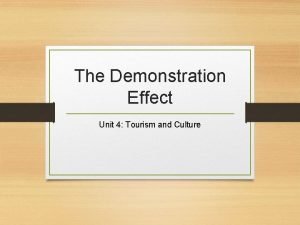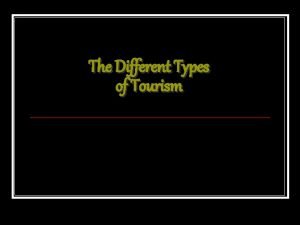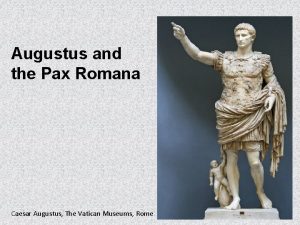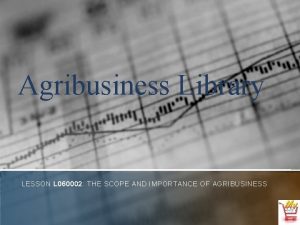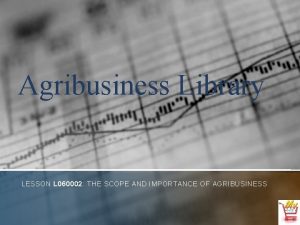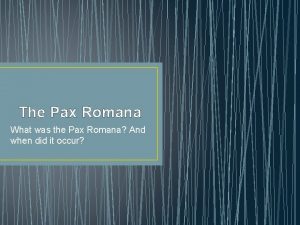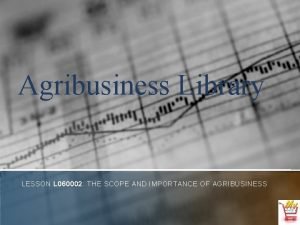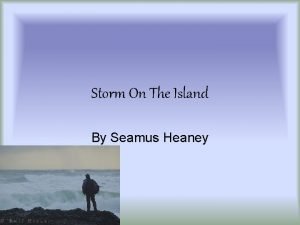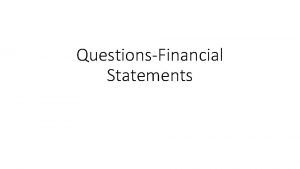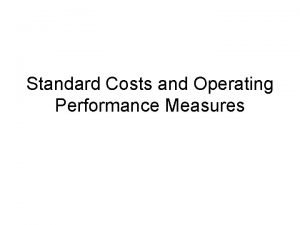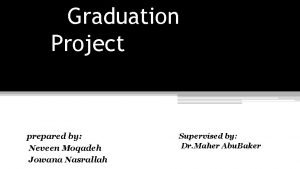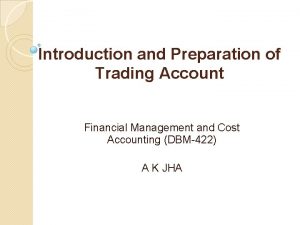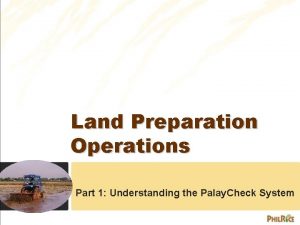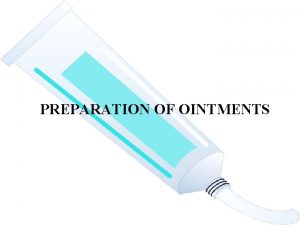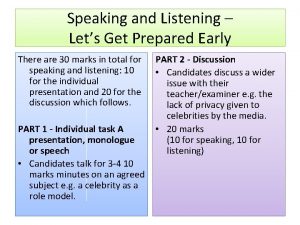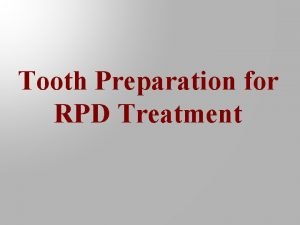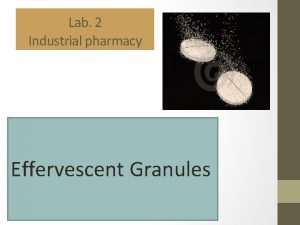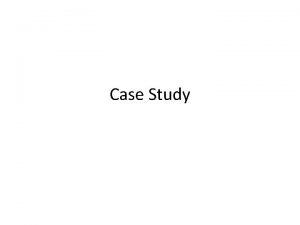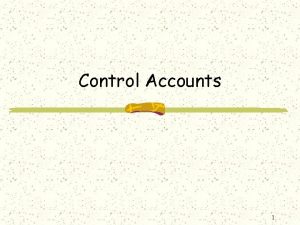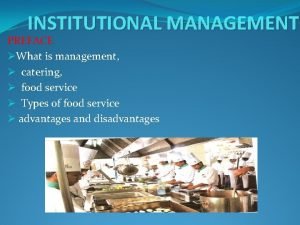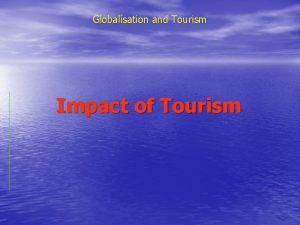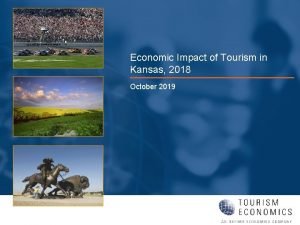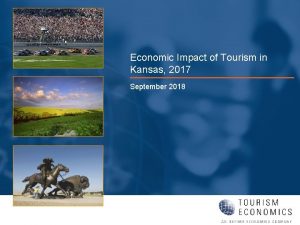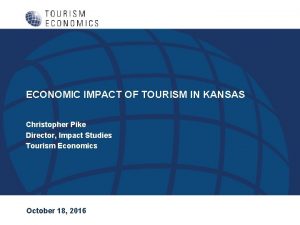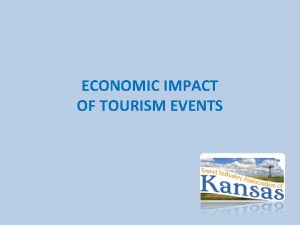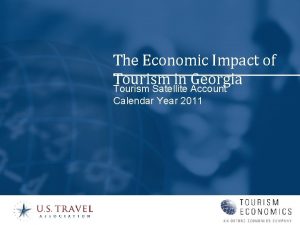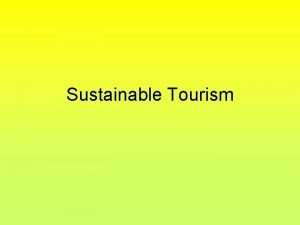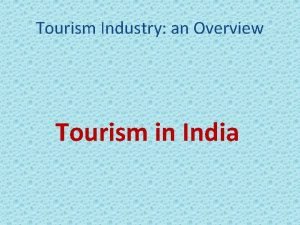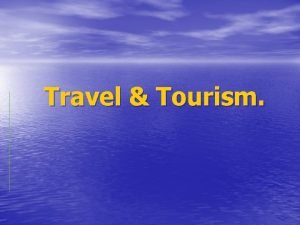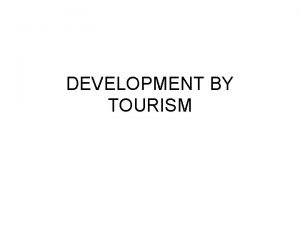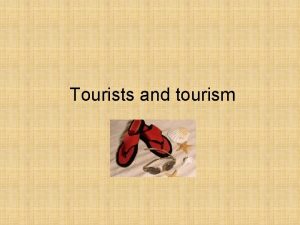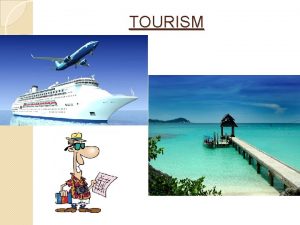ECONOMIC IMPACT OF TOURISM IN KANSAS 2019 Prepared







































- Slides: 39

ECONOMIC IMPACT OF TOURISM IN KANSAS 2019 Prepared for: Kansas Department of Wildlife, Parks and Tourism WWW. TOURISMECONOMICS. COM

INTRODUCTION The travel sector is an integral part of the Kansas economy. Visitors generate significant economic benefits to households, businesses, and government alike and represent a critical driver of Kansas’s future. Employment supported by visitor activity rose to 97, 200 – 5. 4% of all employment in the state. By monitoring the visitor economy, policymakers can inform decisions regarding the funding and prioritization of the sector’s development. They can also carefully monitor its successes and future needs. This is particularly true for Kansas as it builds upon its tourism economy. By establishing a baseline of economic impacts, the industry can track its progress over time. To quantify the economic significance of the tourism sector in Kansas, Tourism Economics has prepared a comprehensive model detailing the wide-reaching impacts arising from visitor spending. The results of this study show the scope of the travel sector in terms of direct visitor spending, as well as the total economic impacts, jobs, personal income, and fiscal (tax) impacts in the broader economy. 2 The analysis draws on the following data sources: • D. K. Shifflet: survey data, including spending and visitor profile characteristics for visitors to Kansas • Bureau of Economic Analysis and Bureau of Labor Statistics: employment and wage data, by industry • STR: Lodging performance data, including room demand, room rates, occupancy, and room revenue • US Census: business sales by industry and seasonal second homes inventory • Kansas Department of Revenue – sales tax data by industry and other data points • Kansas Gaming Commission – casino information

KEY FINDINGS

KEY FINDINGS The visitor economy is an engine for economic growth Visitor Spending Employment Generator In 2019, 36. 5 million visitors spent $7. 3 billion in Employment directly supported by visitor Kansas. spending increased has increased by 2, 800 jobs since 2015. 4 Growth continues Fiscal Contributions Visitor spending increased 3. 1% in 2019, Visitors generated $671 million in state and local stronger than the five-year annual average of taxes, which is equivalent to $600 in tax savings 2. 8%. for every household in Kansas.

VISITATION AND SPENDING

VISITOR SPENDING TRENDS Continued growth in 2019 Visitation increased by 1 million visitors in 2019 Growth in visitation and spending This represents both the largest increase and strongest growth in visitation since 2013 Kansas tourism indicators accelerated in 2019. Visitation growth was led by both day and overnight Visitor spending growth continued in 2019 leisure visitors, the latter of which was supported by a Visitor spending growth increased 3. 1% in 2019 to surge in room demand. Visitation growth supported reach $7. 3 billion. overall spending growth in the state. Increases in food and lodging spending supported overall growth Visitor spending on food & beverages increased by 4. 7% in 2019, leading all categories. 6

VISITATION Total visitor count Visitation growth surged 2. 8% in 2019, the fastest in the last five years. In 2019, Kansas welcomed 36. 5 million visitors. Visitation has increased by 1. 2 million person-trips since 2015 with 80% of that growth occurring in 2019. Kansas visitation levels (millions) 2. 8% 1. 0% A 2. 3% increase in room demand helped support overnight visitation, while lower gas prices and a healthy economy in 2019 helped push day visitation higher. Both day and overnight visitation growth supported overall visitation growth. Visitation growth was supported by growth in several seasons. After struggling in 2018, the key summer season had strong room demand, led by 7. 9% growth in June. Building off strong growth in 2018, the fall season continued to grow; October registered room demand growth of nearly 4%. 7 Source: DK Shifflet, Tourism Economics 0. 5% 0. 3%

SPENDING Total visitor spending Kansas visitor spending ($ billions) Visitor spending in Kansas grew 3. 1% in 2019 to reach $7. 3 billion. 3. 1% 4. 6% Visitor spending increased by $220 million in 2019 and has grown by $775 million since 2015, an overall increase of 12. 6%. 2. 1% With gas prices falling and minimal price pressures from other key spending categories, the spending increase was largely driven by visitation growth. Source: DK Shifflet, Tourism Economics 8 1. 5%

SPENDING Spending by category - 2019 TOTAL VISITOR SPENDING The $7. 3 billion spent by visitors to Kansas was spread across a wide range of sectors Of the $7. 3 billion spent in Kansas in 2019 by visitors, a quarter was spent on transportation in the state. Food & beverage spending captures $1. 8 billion – 24. 6% of the average visitor dollar. Visitors spent 18. 5% on lodging, which includes both room rentals as well as 2 nd home rental income. LOCAL TRANSP. $1. 8 B 25. 1% FOOD & BEVERAGE $1. 8 B 24. 6% About 15 cents of each visitor dollar went to retail shopping while in the state. Source: DK Shifflet, Tourism Economics The $1. 0 billion in the state spent at recreational businesses is 13. 6% of each visitor dollar. 9 LODGING RETAIL $1. 4 B 18. 5% $1. 1 B 14. 8% RECREATION AIR $1. 0 B 13. 6% $0. 2 B 3. 3%

SPENDING Visitor spending timeline Visitor spending has increased by $775 million since 2015. Visitor spending growth on food and beverages supported overall spending growth. Lodging spending growth in 2019 also helped bring up the annual results, while lower growth in shopping by visitors capped growth. Visitor spending on food & beverages has grown by $250 million since 2015, the largest increase by any category. While 2019 s growth in recreational spending by visitors was slightly lower than overall spending growth, recreational spending has supported overall visitor spending growth over the past five years, increasing by 4. 4% annually. 10 Visitor Spending in Kansas, 2015 -2019 Amounts in millions of dollars

SPENDING Spending by category Kansas visitor spending ($ millions) Visitor spending on recreational activities reached $1. 2 billion in 2019 and has grown by 20% since 2015, an increase of $190 million. Food & beverage spending has increased by $250 million since 2015; 60% of this growth has occurred in just the last year. Source: Tourism Economics 11

SPENDING Visitor spending shares Kansas visitor spending (shares) With the strong increases in spending on recreational activities over the last few years, the share of the visitor dollar spent at amusement and entertainment businesses has risen from 15. 3% to 16. 3% in 2019. The share of the visitor dollar spent on lodging rose slightly in 2019, registering 15. 9%. The share of the visitor dollar spent on food & beverages is another category that has increased in importance as measured by its spending share, reaching 24. 6% in 2019. Source: Tourism Economics 12

VISITATION AND SPENDING Day/overnight splits Each traveler spends $200 on their trip to Kansas. Trips and spending, 2015 -2019 Amounts in nominal dollars and number of visitors 36. 5 million overnight person trips spent $7. 3 billion in visitor spending to Kansas. Day visitation grew to 21. 6 million person trips, with spending increasing to $1. 7 billion in 2019. Overnight visitors comprise about 40% of all visitors but spend about 77% of all visitor spending. Spending increases were seen from the overnight visitors as per-traveler spending of overnight visitors rose $10 to $378 in 2019. Source: Tourism Economics 13

SPENDING Visitor spending by market Spending share by market, 2019 Kansas spending by market Expressed as a percentage of total expenditure per market Amounts in millions of nominal dollars and percent of total Busines s International Day Leisure Domestic Overnight Source: Tourism Economics 14

TOURISM ECONOMY

TOURISM SATELLITE ACCOUNT Investment $613 million was spent on construction costs in support of the tourism industry in Kansas. Tourism capital investment, 2015 -2019 Amounts in nominal dollars and number of visitors Spending on machinery & equipment reached $364 million in 2019, an increase of 3. 2%. New construction rebounded in 2019, climbing back to $250 million. New construction spending grew 40% in 2019 after having fallen 30% in 2018. 16 Source: Dodge Construction; Tourism Economics

TOURISM SATELLITE ACCOUNT Category contributions - 2019 Visitors to Kansas supported a total of $8. 1 TOURISM SATELLITE ACCOUNT billion in expenditures in 2019 INVESTMT $0. 6 B Domestic visitors provided the majority of tourism economy spending at $7. 1 billion, 88% of the total. Investment spending added 8%. International visitors 8% DOMESTIC VISITOR $7. 1 B 88% and their $250 million in spending were 3% of the total. INTL. VISITOR $0. 2 B PCE Personal consumption spending in support of tourism GOVM’T and governmental support were $69 million and $58 million respectively in 2019, 1. 6% of the total. 17 Source: Tourism Economics 3%

TOURISM SATELLITE ACCOUNT Tourism economy in Kansas Non-visitor private consumption expenditures (PCE) represent tourism consumer durables such as an RV, boat, or furniture for a vacation home. Tourism economy spending, 2015 -2019 Amounts in nominal dollars Government support for tourism includes the budgets for destination marketing and other budget items in broad support of tourism. Capital investment (CAPEX) includes construction of hotels and attractions, as well as tourism equipment and infrastructure. 18 Source: Tourism Economics

DIRECT IMPACTS

TOURISM INDUSTRY IMPACTS The tourism industry consists of visitor spending and its direct impacts on the state economy. Core tourism Amounts in number of jobs and millions of nominal dollars Tourism GDP is the value added of those sectors directly interacting with travelers. The narrow definition of the tourism industry counts only tourism industry sales, which excludes capital investment and general government support of tourism. This definition is consistent with economic accounts. On this basis, tourism industry GDP tallied $3. 0 billion in 2019, and tourism industry employment reached 66, 007, 3. 4% of all Kansas employment. Source: Tourism Economics 20

DIRECT TOURISM INDUSTRY Tourism employment growth Visitor spending directly supported 66, 007 jobs Tourism supported employment in Kansas Amounts in number of jobs and year-on-year percentage growth 1. 0% The number of jobs directly supported by tourism increased by 655 jobs, growth of 1. 0% 1. 6% Direct tourism employment has grown by over 2, 800 jobs since 2015. 0. 8% These 66, 000 jobs represent 3. 4% of all jobs in Kansas. One out of every 30 jobs is directly supported by visitor spending. Source: Tourism Economics 21

DIRECT TOURISM INDUSTRY Tourism employment In 2019, tourism was the 9 th largest employer in Employment in Kansas, by major industry Kansas Amounts in number of jobs Visitor activity directly supported 66, 000 jobs in Kansas in 2019. Comparing this with the direct employment in other industry sectors, tourism would rank as the 9 th largest industry. Source: Tourism Economics, BEA 22

DIRECT TOURISM INDUSTRY Tourism employment intensity Amounts in percentage of total industry employment Tourism employment is a significant part of several industries – the majority of lodging employment, 33% of recreation, and 23% of food & beverage employment is supported by tourism spending. 23

ECONOMIC IMPACTS

ECONOMIC IMPACTS Our analysis of tourism's impact on Kansas How visitor spending generates employment and income begins with actual spending by visitors, but economic value within a discreet group of also considers the downstream effects of this sectors (e. g. recreation, transportation). injection of spending into the local economy. This supports a relative proportion of To determine the total economic impact of jobs, wages, taxes, and GDP within each tourism in Kansas, we input visitor spending sector. into a model of the Kansas economy created in IMPLAN. This move calculates three distinct types of impact: direct, indirect, and induced. The impacts on business sales, jobs, wages, and taxes are calculated for all three levels of impact. 1. Direct Impacts: Visitors create direct 2. Indirect Impacts: Each directly affected sector also purchases goods and services as inputs (e. g. food wholesalers, utilities) into production. These impacts are called indirect impacts. 3. Induced Impacts: Lastly, the induced impact is generated when employees whose wages are generated wither directly or indirectly by visitors, spend those wages in the local economy. 25

ECONOMIC IMPACTS How visitor spending generates employment and income Economic impact flowchart TOTAL IMPACTS VISITOR IMPLAN calculates these three levels of impact – direct, indirect, and induced – for a broad set of SPENDING Accommodation Supply-side effects indicators. These include the following: • Spending • Wages Food & beverage Goods & services purchases Production INDIRECT EFFECTS Jobs Retail • Employment • Federal Taxes Entertainment/rec • State Taxes Household purchases Household tax impacts Wages INDUCED EFFECTS Local transportation • Local Taxes Air transportation 26

ECONOMIC IMPACTS Business sales by industry Business sales impacts by industry Spending in support of visitor activity reached $8. 1 billion in Kansas in 2019. This supported a total of $11. 8 billion in business sales when indirect and induced impacts are considered. Summary economic impacts ($ billions) Source: IMPLAN, Tourism Economics 27

ECONOMIC IMPACTS Business sales by industry Business sales impacts by industry While the majority of sales are in industries directly serving visitors, $530 million in business services industry sales is happening as a result of selling to tourism businesses. Significant benefits also accrue in sectors like finance, insurance, and real estate (FIRE), manufacturing and communications from selling to tourism businesses and employees. $ millions Source: IMPLAN, Tourism Economics 28

ECONOMIC IMPACTS GDP impacts by industry Tourism generated $5. 4 billion in local GDP in 2019, or 2. 9% of the Kansas economy. This excludes all import leakages to arrive at the economic value generated by traveler activity in the state. Summary GDP impacts ($ billions) Source: IMPLAN, Tourism Economics 29

ECONOMIC IMPACTS GDP impacts by industry In Kansas, the food & beverages industry has the largest local value created by visitor activity. Lodging, as well as finance, insurance, and real estate follow as industries providing value to Kansas from visitor activity. Ranking 4 th is the recreational industry followed by business services. This industry significantly benefits from indirect and induced activity that is supported by visitor activity. Food & Beverage Lodging FIRE* Recreation and Entertainment Construction and Utilities Business Services Retail Trade Government Education and Health Care Other Transport Personal Services Gasoline Stations Wholesale Trade Communications Manufacturing Air Transport Agriculture, Fishing, Mining Direct Induced $ millions $0 Source: IMPLAN, Tourism Economics 30 Indirect $400 $800 $1 200

ECONOMIC IMPACTS Employment Tourism supported a total of 97, 234 jobs when indirect Employment Impacts and induced impacts are considered. This represents 5. 0% of all jobs in the state – or one out of every 20 jobs in Kansas. Summary employment impacts (number of jobs) Source: IMPLAN, Tourism Economics 31

ECONOMIC IMPACTS Employment Impacts Visitor spending supports the largest number of jobs in the food & beverage industry in Kansas – 28, 400. The majority of those jobs are directly supported by visitor activity. Another 12, 500 to 13, 000 jobs in each of the recreation and lodging industries are supported by visitor spending. Over 12, 700 Kansas-based jobs are indirectly supported by visitor activity. Food & Beverage Lodging Recreation and Entertainment Retail Trade Business Services Other Transport FIRE* Construction and Utilities Personal Services Education and Health Care Government Gasoline Stations Air Transport Manufacturing Wholesale Trade Communications Agriculture, Fishing, Mining Direct Induced 0 5 000 Source: IMPLAN, Tourism Economics 32 10 000 15 000 20 000 25 000 30 000

ECONOMIC IMPACTS Personal income impacts Tourism generated $2. 0 billion in direct income and $3. 3 billion when indirect and induced impacts are considered. Summary personal income impacts ($ billions) Source: IMPLAN, Tourism Economics 33

ECONOMIC IMPACTS Personal income impacts There are eleven industries in which visitor activity supports more than $150 million in personal income. These range from the obvious—food & beverages and lodging, to the less obvious—business services and education & health care. Despite ranking a distant fifth in terms of jobs supported, the higher wages in the business services industries supported by visitor activity provide $330 million in income to Kansas job holders, the second largest impact. Food & Beverage Business Services Lodging Construction and Utilities Recreation and Entertainment Retail Trade Finance, Insurance and Real Estate Education and Health Care Other Transport Government Personal Services Gasoline Stations Wholesale Trade Manufacturing Communications Air Transport Agriculture, Fishing, Mining Direct $0 Indirect Induced $100 $200 $300 $400 $500 $600 $700 $800 Source: IMPLAN, Tourism Economics $ millions 34

ECONOMIC IMPACTS Fiscal (tax) Tax impacts Visitor spending, visitor supported jobs, and business sales generated $1. 1 billion in governmental revenues. State and local taxes alone tallied $671 million in 2019. Each household in Kansas would need to be taxed an additional $600 per year to replace the traveler taxes received by state and local governments. Source: IMPLAN, Tourism Economics 35

ECONOMIC IMPACTS Fiscal (tax) Visitor spending, visitor supported jobs, and business sales Tax impacts generated $671 million in governmental revenues. Visitor activity supported $302 million in state tax revenues in 2019. Local governments received $369 million in revenue from economic activity associated with visitors. For the state, sales tax receipts provide a large share of governmental revenues. For local governments, property taxes along with bed and sales taxes provide the majority of governmental revenues. 36 Source: IMPLAN, Tourism Economics

ECONOMIC IMPACT IN CONTEXT

ECONOMIC IMPACTS IN CONTEXT Figures in context Visitor spending Employment Stacking $7. 3 billion worth of $5 bills would reach Tourism supports 97, 234 Kansas jobs in 2019– 100 miles high– similar to the distance from enough to fill Bill Snyder Family Stadium twice Salina to Hays. over. Total visitor business sales Taxes The $11. 8 billion in total impact in 2019 is similar To make up for the $671 million in state and local in size to what Americans spend on bottled water taxes generated by visitor activity, each in a year. household in the state would need to contribute $600 to maintain the current level of government. 38

ABOUT TOURISM ECONOMICS Tourism Economics is an Oxford Economics company with a singular objective: combine an understanding of the travel sector with proven economic tools to answer the most important questions facing our clients. More than 500 companies, associations, and destination work with Tourism Economics every year as a research partner. We bring decades of experience to every engagement to help our clients make better marketing, investment, and policy decisions. Our team of highly-specialized economists deliver: • Global travel data-sets with the broadest set of country, city, and state coverage available • Travel forecasts that are directly linked to the economic and demographic outlook for origins and destinations • Economic impact analysis that highlights the value of visitors, events, developments, and industry segments • Policy analysis that informs critical funding, taxation, and travel facilitation decisions • Market assessments that define market allocation and investment decisions Tourism Economics operates out of regional headquarters in Philadelphia and Oxford, with offices in Belfast, Buenos Aires, Dubai, Frankfurt, and Ontario. Oxford Economics is one of the world’s foremost independent global advisory firms, providing reports, forecasts and analytical tools on 200 countries, 100 industrial sectors and over 3, 000 cities. Our best-of-class global economic and industry models and analytical tools give us an unparalleled ability to forecast external market trends and assess their economic, social and business impact. Headquartered in Oxford, England, with regional centers in London, New York, and Singapore, Oxford Economics has offices across the globe in Belfast, Chicago, Dubai, Miami, Milan, Paris, Philadelphia, San Francisco, and Washington DC, we employ over 250 full-time staff, including 150 professional economists, industry experts and business editors—one of the largest teams of macroeconomists and thought leadership specialists. For more information: info@tourismeconomics. com 39
 Positive impact of economic in tourism
Positive impact of economic in tourism Kansas kansas state fight
Kansas kansas state fight What is demonstration effect
What is demonstration effect Mass tourism vs alternative tourism
Mass tourism vs alternative tourism What is the scope and economic impact of agribusiness
What is the scope and economic impact of agribusiness Pax romana economic impact
Pax romana economic impact What is the scope and economic impact of agribusiness
What is the scope and economic impact of agribusiness What is the scope and economic impact of agribusiness
What is the scope and economic impact of agribusiness When did pax romana begin
When did pax romana begin What is the scope and economic impact of agribusiness
What is the scope and economic impact of agribusiness Lesson 2 our economic choices
Lesson 2 our economic choices Economic growth vs economic development
Economic growth vs economic development Economic development vs economic growth
Economic development vs economic growth How the periscope works
How the periscope works Storm on the island poem analysis
Storm on the island poem analysis What is a preliminary strand test
What is a preliminary strand test δwc
δwc Prepared exclusively for
Prepared exclusively for Standard cost is a
Standard cost is a Past form of prepared
Past form of prepared Always be prepared to give an answer
Always be prepared to give an answer Prepared exclusively for
Prepared exclusively for An item prepared with the intent to deceive
An item prepared with the intent to deceive Descion tree
Descion tree Ezra the scribe
Ezra the scribe Trading account is prepared to find out? *
Trading account is prepared to find out? * The business plan should be prepared by
The business plan should be prepared by In williamson’s synthesis, ethoxyethane is prepared by-
In williamson’s synthesis, ethoxyethane is prepared by- Liquid dosage forms
Liquid dosage forms Differentiate wetland and dryland preparation
Differentiate wetland and dryland preparation Prepared programming
Prepared programming Preparation of ointments
Preparation of ointments Let's get prepared
Let's get prepared Incisal rest
Incisal rest Granules in pharmacy
Granules in pharmacy Dodero company produces a single product
Dodero company produces a single product Romeo and juliet act 4 scene 5 summary
Romeo and juliet act 4 scene 5 summary Count 3. hali
Count 3. hali What is control account
What is control account Institutional food service
Institutional food service


